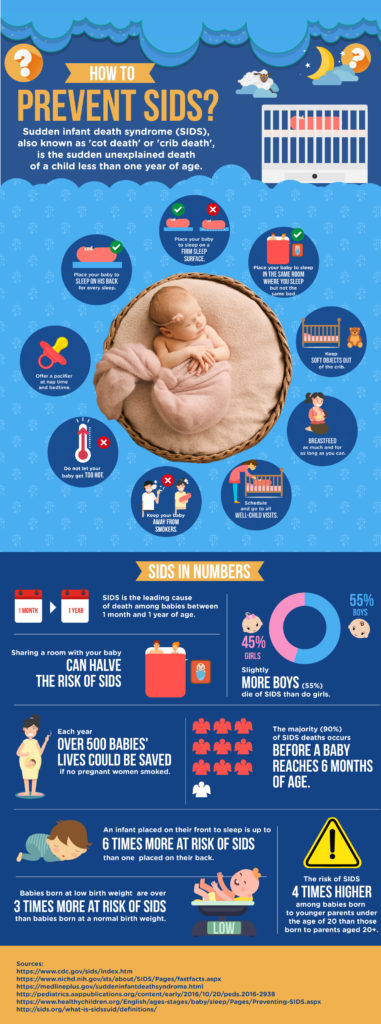Visit and Join the WeHeal Sudden Infant Death Syndrome Community
Information and References: MayoClinic | Wikipedia
Clinical Trials: Clinicaltrials.gov | In Clinical Trials | EU Clinical Trials Register | WeHeal Guide to Researching Clinical Trials
Patient Resources and Related Organizations: American SIDS I*nstitute
News and Media: News-Medical.net | NIH
Sudden infant death syndrome (SIDS), also known as cot death or crib death, is the sudden unexplained death of a child less than one year of age.
WeHeal is very grateful to our valued sources of information which include Wikipedia, WebMD, ClinicalTrials.gov, Cancer.gov, Infoplease, and the US CDC (Center for Disease Control).

There’s no guaranteed way to prevent SIDS, but you can help your baby sleep more safely by following these tips:
-
- Back to sleep. Place your baby to sleep resting on his or her back, rather than on the stomach or side. This isn’t necessary when your baby’s awake or able to roll over both ways without help.
-
- Don’t assume that others will place your baby to sleep in the correct position — insist on it. Advise sitters and child care personnel not to use the stomach position to calm an upset baby.
-
- Keep the crib as bare as possible. Use a firm mattress and avoid placing your baby on thick, fluffy padding, such as lambskin or a thick quilt. Don’t leave pillows, fluffy toys or stuffed animals in the crib. These may interfere with breathing if your baby’s face presses against them.
-
- Don’t overheat baby. To keep your baby warm, try a sleep sack or other sleep clothing that doesn’t require additional covers. If you use a blanket, make it lightweight.
-
- Tuck the blanket securely into the foot of the mattress, with just enough length to cover your baby’s shoulders. Then place your baby in the crib, near the foot, covered loosely with the blanket. Don’t cover your baby’s head.
-
- Baby should sleep alone. Your baby’s sleeping in the same room with you is a great idea, but adult beds aren’t safe for infants. A baby can become trapped and suffocate between the headboard slats, the space between the mattress and the bed frame, or the space between the mattress and the wall.
-
- A baby can also suffocate if a sleeping parent accidentally rolls over and covers the baby’s nose and mouth.
-
- Breast-feed your baby, if possible. Breast-feeding for at least six months lowers the risk of SIDS.
-
- Avoid baby monitors and other commercial devices that claim to reduce the risk of SIDS. The American Academy of Pediatrics discourages the use of monitors and other devices because of ineffectiveness and safety issues.
-
- Offer a pacifier. Sucking on a pacifier at naptime and bedtime may reduce the risk of SIDS. One caveat — if you’re breast-feeding, wait to offer a pacifier until your baby is 3 to 4 weeks old and you’ve settled into an effective nursing routine.
- If your baby’s not interested in the pacifier, don’t force it. Try again another day. If the pacifier falls out of your baby’s mouth while he or she is sleeping, don’t pop it back in.
This info-graphic was provide by Zoey Miller http://www.thebabbleout.com/